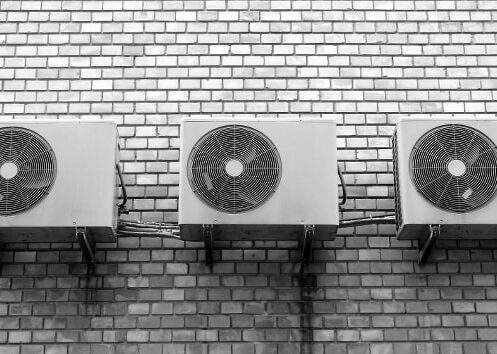Ductwork is tricky. For starters, you’ve got to design and install it properly. Then you have to seal it to avoid leakage. After a few years, you might even have to clean it to improve indoor air quality.
Sheesh. All that work just to blow some air around.
But did you know that many of the highest-performing heaters and air conditioners on the market don’t use ducts at all? Seriously. These exist.
They’re called ductless mini-split heat pumps, and they’re awesome! Also known simply as “mini-splits,” these units consist of a small outdoor unit and an even smaller indoor unit (or units) mounted inside the space you’re heating or cooling. We like them because:
- They’re incredibly efficient: Typical SEER for mini-splits ranges from 21 to 30. Traditional systems generally top out at 21.
- No ducts = fewer problems: Mini splits still require regular maintenance, but you won’t have nearly as many issues with air leakage (no ducts to leak from!), airflow, or indoor air quality.
- Automatic zoning: Different indoor units live in different areas of your house. Each one heats and cools a designated space, so you get out-of-the-box zoning without those pesky dampers, bypass ducts, or extra outdoor and indoor coils.
- They’re quiet: If you’re tired of hearing that “whoosh” of air when your system kicks on, you’ll love these units.
Mini-splits usually mount to a wall, but you can also get floor-mounted models, ceiling-recessed units, traditional ducted air handlers (Yep – some mini-splits do have ducts. More on that in a bit), or low-static ducted air handlers (for single rooms). The wall-mounted units look like this:
candidate for a mini-split heat pump? It all depends on what kind of HVAC infrastructure you’ve already got – and what you’re trying to achieve.
Mini-split heat pumps for additions and retrofits
Mini-splits are great when you need a way to heat and cool a new room that you just built onto your house. It isn’t always easy to connect ducts from the new room to an existing HVAC system. Duct installation aside, you might also need to scrap your existing equipment and replace it to handle the new load requirements.
You probably don’t want to do that. Thankfully, a mini-split can save the day.
Using a mini-split, you can heat and cool the new space without fooling with your ductwork or burdening your existing HVAC equipment. You’ll also gain room-level control of temperatures year-round.
In much the same sense, mini splits can be great for renovations. Maybe you’re retrofitting an old house that never had a central HVAC system. Or maybe you need to replace an old central system, including the ducts, but don’t want to trouble yourself with all of the ductwork “issues” we discussed earlier. Just install a mini-split or two (or three or four depending on the application), and you’ll be good to go.
Don’t want a window unit AC? Go mini-mini split
Traditionally, window unit air conditioners have been the go-to solution for hot upstairs bonus rooms. They’re also a simple way to cool homes that don’t have a central HVAC system or can’t achieve proper airflow in certain spaces.
But there are problems with window units:
- They block light. You’re giving all or half of a window to an appliance. Instead of sunlight, you’re looking at plastic all the time. And nobs. And dials. And digital displays. Ugh.
- Many people consider them unsightly. This could be an issue if you need AC in a room on the front-facing side of your house. Everyone will see your AC from the street.
- Some HOAs prohibit them. If your community has an HOA, there might be a line in your covenants that forbids window unit air conditioners.
- They’re noisy. This is better than it used to be, but even the new units are pretty loud.
- They’re a security risk. Someone can push the window unit into your home and come in through the window.
Enter the mini split! Not only can you reclaim some sunlight, but the outdoor unit will probably live somewhere along the side or back of your home – out of view. It won’t be hanging out the window for all the world to see.
To be sure, you’ll need to select an appropriately sized mini split for your room. This is where HVAC consulting and design can come in handy (more on that shortly).
Oh, and if you love efficiency…
Energy efficiency diehards love mini-split heat pumps. It’s simply the only way to go if your goal is to use the most energy-efficient HVAC equipment on the market:
- They’ve got the highest SEER.
- Ductless models don’t have to push air through ducts, which is where a lot of efficiencies are lost.
- The long-term cost savings of their extraordinary efficiency often negates the larger up-front expense.
If you’re starting to think, “Hey, I should outfit my whole house with these things,” you’re onto something. A lot of ultra-efficient new construction incorporates mini-splits into the design, and many owners of existing homes are retrofitting their living spaces to accommodate mini-splits.
But what do you do if you have, say… three small upstairs bedrooms and a small bathroom? One room might only require 2,000 BTUs, but the smallest ductless mini split is a 6,000 BTU unit. The ductless unit offers variable airflow, so it can ramp down to accommodate the smaller load. Here’s the thing, though:
You don’t want a mini-split unit in every little room. They take up space and getting lots of them isn’t cost-effective.
What should you do?
Ducted mini splits help with tricky situations
Not all mini splits are ductless! Some are designed to have short duct runs (think low static pressure) and accommodate loads of various small spaces throughout your home. They also “hide” in your floors, walls, or ceilings, so nobody can see them. This is a nice option if you don’t like the way ductless models look.
The air registers on your ceilings and walls make it appear as if you have a normal ducted system. Which you do… sort of.
Take our scenario from above: Three small upstairs bedrooms plus a bathroom. Depending on the load requirements, you might have one or two mini splits hidden in the ceiling that feed air through short duct runs connected to each of those rooms. You lose a little efficiency because of the ducts, but not much. And you still get the benefit of room-level zoning.
You can outfit your entire house with a combination of ductless and ducted mini splits! Some homeowners only use one type. Others use both. The availability of ducted installations gives you the flexibility to go mini-split in just about any situation.
An HVAC consultation helps you decide
Do you need a mini-split system to help you achieve your goals of comfort and efficiency? Would a traditional system work best? What about two ducted HVAC systems vs. two or three mini-splits?
The questions are numerous. That’s where a consultation can help.
There are usually multiple ways to help you get a comfortable, efficient HVAC setup. Mini-splits are sometimes a part of that. Sometimes they aren’t. Unless your goals are super straightforward, one thing we do before installing a mini-split heat pump is analyze your home and provide a consultation. It’s free, of course.
Depending on the application, we can present a variety of options with varying costs and installation requirements. Mini-splits often cost more than traditional equipment, but not always. If you’re replacing a traditional system with all of your ductwork, a single-zone mini-split system might cost less. A dual-zone mini-split system might be roughly the same price.
It all depends on what you’re trying to do, and the payoff in terms of comfort and efficiency is usually worth it.
You’ll be more comfortable and save money on utilities each month. And if you go full-on ductless, you’ll never have to place another strip of foil tape on another duct joint ever again.

